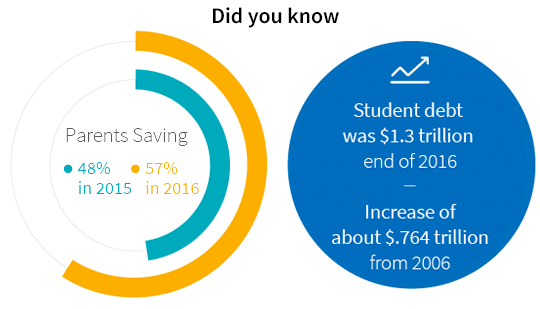FIND WHAT YOU NEED

FIND WHAT YOU NEED
Stay on track for financial and practical matters related to college enrollment
Getting ready for college can be a challenging process for parents and students. With so many things to consider as your child approaches college age, this year-by-year guide keeps you on track for both financial and practical matters related to college enrollment.

The four-year action plan
Freshman year

Priorities for parents
Saving and finances
Research
Student action plan
School-based goals
Research
PRIORITIES FOR PARENTS
Savings and finances
- Increase saving in a 529 plan. Encourage grandparents and other family members to get involved.
- Explore prepaid tuition plans that lock in tuition rates at in-state public colleges.
- Consider allocating some savings to other accounts such as custodial UGMA/UTMA for non-qualified 529 plan college expenses, such as transportation.
Research
- Research the affordability of college with Putnam's College Savings calculator.
- Beginning with next year's tax return, all income will be considered in the aid calculation. (See resources on last page.)
STUDENT ACTION PLAN
School-based goals
- Set goals to achieve the honor roll and maintain a solid GPA throughout high school.
- Participate in extracurricular activities. Admissions officers are increasingly looking for deeper involvement and leadership in a few areas (including work) rather than sporadic participation in many different clubs or activities.
Research
- Meet with a guidance counselor to discuss interests and learn how to research colleges.
Sophomore year

Priorities for parents
Saving and finances
Financial aid
Student action plan
School-based goals
Research
PRIORITIES FOR PARENTS
Savings and finances
- Continue saving in 529 plan and review asset allocation to ensure that the investments are on track with the time horizon.
- Compare living expenses of targeted schools as costs vary by location.
Financial aid
- Consider tax-smart strategies and the impact of income on federal financial aid (FAFSA).
- Beginning with next year's tax return, all income will be considered in the aid calculation. (See resources on last page.)
STUDENT ACTION PLAN
School-based goals
- Begin standardized testing by taking the PSAT in October.
- Consider a course schedule for junior and senior year to include Advanced Placement (AP) courses and postsecondary enrollment options.
Research
- Research colleges and include international colleges that may be more affordable, even after travel expenses.
- Research academic requirements. It is important to start early especially when considering a military academy.
- If pursuing athletics, complete online college recruiting forms, contact coaches, and register with the NCAA if required.
Junior year

Priorities for parents
Saving and finances
Research
Student action plan
School-based goals
Research
PRIORITIES FOR PARENTS
Savings and finances
- Explore a home equity loan as a potential source of funding.
Financial aid
- Determine the Expected Family Contribution (EFC) for financial aid. The EFC process factors income from the "prior" year. Note that increases in income — for example, from the sale of a stock or a Roth IRA conversion — may affect aid.
- The financial aid calculator (FAFSA4caster) on the FAFSA website can estimate potential financial aid. Review 529 account ownership to determine if changes are appropriate when considering financial aid.
- Research whether targeted colleges require the College Scholarship Service Profile (CSS Profile) application as part of their financial aid process.
- Start compiling information for FAFSA submission including: tax returns and information on savings, investments, and assets.
STUDENT ACTION PLAN
School-based goals
- Keep a calendar of tests (PSAT in October; SAT, SAT subject tests, and ACT later in the year).
- Take a prep course or find a tutor for standardized tests.
- Make sure coursework, such as number of AP classes, reflects the academic requirement of targeted schools.
- Start building a resume and include summer employment, internships, and achievements.
- Meet with teachers, coaches, or mentors in person to request letters of recommendation.
Research
- Research colleges and attend college fairs. Think about an area of interest to pursue; this will help drive the list of colleges.
- Begin college visits in the fall. Get advice from older friends and family who have recently gone through the process.
Senior year

Priorities for parents
Saving and finances
Financial aid
Key documents
Student action plan
Application process
Campus visits
PRIORITIES FOR PARENTS
Savings and finances
- Ask employer if scholarships are available for children attending college.
- Make sure you have enough liquid assets for college-related expenses. This may require investment transfers within college savings accounts to more conservative options.
- Consider allocating funds within a custodial account (i.e., UGMA or UTMA) or regular savings account for travel costs, which are not considered "qualified expenses" for 529 plans.
- Identify which savings accounts to tap into first for expenses based on investment, tax, or financial aid considerations.
- Research tax credits and deductions to help with college costs.
Financial aid
- Attend a college aid workshop or meet with a professional college counselor.
- Complete the FAFSA form (between October 1 and June 30). Bear in mind that many states and colleges request FAFSA submission as soon as possible after October 1.
Key documents
- Have student complete a health-care proxy when turning 18 and before going to college.
STUDENT ACTION PLAN
School-based goals
- Take the SAT/ACT in the fall.
- Review social media accounts to make sure profiles and posted content would not jeopardize an admissions decision.
- Establish a professional presence by creating a LinkedIn profile.
Application process
- Over the summer before senior year, start working on Common Application and college essay.
- Research application options, including early decision, early action, regular admission, and rolling admission.
- If opting for early decision, apply to colleges as early as November.
- Research and apply for local scholarships from schools, towns, and relevant organizations.
Campus visits
- Find out which schools offer interviews and set up meetings. Schedule campus visits when school is in session to experience daily life on campus. Trim your college list to a few safety, match, and reach schools.
- If pursuing athletics, contact coaches to schedule official on-campus visits in the fall.
For students, planning for college is an exciting time to think about the future. It also involves many important actions and deadlines that need to be met during high school. Staying organized will be key to take advantage of opportunities as you prepare for college. For parents, the window to save may have narrowed, but there is still time to optimize financial decisions.
It is important for families to consider potential tax advantages and liabilities. Assets outside of college savings accounts may add to the complexity. Parents must be mindful of account ownership and income that can affect their child’s eligibility for financial aid. Having a plan to make withdrawals for college expenses is as important as planning to save. At all stages of planning for college, it is important to meet with a financial professional.
